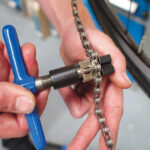Many mountain bikers experience discomfort, such as knee or hip pain, without realizing that their Mtb Bike Cranks could be a contributing factor. For years, conventional wisdom in bike manufacturing has leaned towards longer crank arms, but recent insights suggest this might be incorrect, potentially leading to discomfort and even injury for many riders.
A compelling article from bike fitters sheds light on the correlation between inseam length and optimal crank length. Their findings, detailed in “At All Levels and Categories of Cycling: Correct Poor Crank-arm Fit to Relieve Chronic Knee (and Hip) Pain,” indicate that cyclists with shorter inseams should consider shorter cranks to improve biomechanics and reduce strain. For instance, the study suggests a rider with a 28-inch inseam (approximately 71cm) might benefit from 150mm cranks, while those with longer legs, like a 35.5-inch inseam (90cm), should not exceed 173mm crank arms.
This perspective challenges the long-held practice of equipping most standard-sized mountain bikes with 175mm cranks, with even small frames often featuring 170mm arms. The prevalence of longer cranks, especially on older bikes, may be rooted in times before bottom brackets became lower, when pedal strikes were less of a concern. Today, however, the advantages of shorter mtb bike cranks are becoming increasingly apparent.
Shorter crank arms can offer several benefits for mountain bikers. Firstly, they can reduce knee and hip strain by optimizing leg extension and flexion throughout the pedal stroke. This can be particularly beneficial for riders prone to knee or hip pain. Secondly, shorter cranks inherently decrease the likelihood of pedal strikes, a common issue on technical trails. While the market for very short MTB cranks is still developing, with Canfield Bikes being a notable manufacturer of 155mm options, even a shift to 165mm cranks can be a significant improvement. Anecdotal evidence and initial tests suggest that moving to 165mm cranks doesn’t introduce noticeable negatives and, importantly, reduces pedal strikes.
If you’re experiencing knee pain, hip discomfort, or consistently tight hips while mountain biking, exploring shorter mtb bike cranks could be a worthwhile experiment. Consider your inseam length and research the recommended crank lengths. Have you considered testing shorter cranks? Share your leg length and current crank arm size in the comments below – and let us know if you decide to try a shorter setup!

